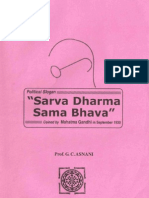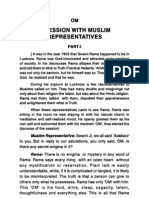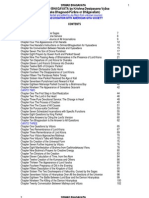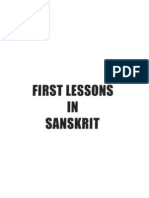Professional Documents
Culture Documents
The Wonder That Is Sanskrit - Excerpt
Uploaded by
api-3706121100%(4)100% found this document useful (4 votes)
4K views20 pagesThis booklet is an excerpt from the book "The Wonder that is Sanskrit" by Sampad and Vijay, published by Sri Aurobindo Society, Pondicherry. The authors have really succeeded in unfolding before the readers the wonderful world of Sanskrit Language - the world of amazing and interesting creations, of the beauty and charm of Sanskrit poetry, of perfect grammar and of the ability of the Sanskrit language to uplift the human soul.
Original Title
The Wonder That is Sanskrit - Excerpt
Copyright
© Attribution Non-Commercial (BY-NC)
Available Formats
PDF or read online from Scribd
Share this document
Did you find this document useful?
Is this content inappropriate?
Report this DocumentThis booklet is an excerpt from the book "The Wonder that is Sanskrit" by Sampad and Vijay, published by Sri Aurobindo Society, Pondicherry. The authors have really succeeded in unfolding before the readers the wonderful world of Sanskrit Language - the world of amazing and interesting creations, of the beauty and charm of Sanskrit poetry, of perfect grammar and of the ability of the Sanskrit language to uplift the human soul.
Copyright:
Attribution Non-Commercial (BY-NC)
Available Formats
Download as PDF or read online from Scribd
100%(4)100% found this document useful (4 votes)
4K views20 pagesThe Wonder That Is Sanskrit - Excerpt
Uploaded by
api-3706121This booklet is an excerpt from the book "The Wonder that is Sanskrit" by Sampad and Vijay, published by Sri Aurobindo Society, Pondicherry. The authors have really succeeded in unfolding before the readers the wonderful world of Sanskrit Language - the world of amazing and interesting creations, of the beauty and charm of Sanskrit poetry, of perfect grammar and of the ability of the Sanskrit language to uplift the human soul.
Copyright:
Attribution Non-Commercial (BY-NC)
Available Formats
Download as PDF or read online from Scribd
You are on page 1of 20
Interesting and Amazing Creations
in Sanskrit
There is in Sanskrit a whole body of literature that is based on a
play with the language. This is not great literature or inspired po-
etry, but more in the nature of linguistic acrobatics. These writings
are often obtuse and not very easy to understand because they
require a great mastery over all the complex grammatical struc-
tures. Therefore, they are known as adhamakavyas, meaning ‘po-
ems of a lower quality’. However, far from being worthless, they
demonstrate the amazing possibilities inherent in the language, along
with the originality and creativity of the writers.
Several great poets, including Kalidasa, Bhartrihari, Magha and
Sriharsha have made use of the adhamakavyas, sometimes even
in their major works, in a spirit of playful indulgence. There are
instances where entire epics have been written in this style. These
are known as citrakavyas and are part of the alankarasastra or
Sanskrit rhetorics. Some of the creations border on the unbeliev-
able and would perhaps be impossible in any other language. Here
we will look briefly at a few examples to enjoy their flavour and
taste.
Varnacitras
The varnacitras are Slokas written with certain constraints on the
36 The Wonder that is Sanskrit
use of consonants. For example, here is a sloka where all the 33
consonants in Sanskrit come in their natural order.
oe Gist aeatserctesvert: |
aah oHahtinatstteanferat ae: A!
Who is he, the lover of birds, pure in intelligence, expert
in stealing the strength of others, leader among the de-
stroyers of the enemies, the steadfast, the fearless, the
one who filled the ocean? He is the king Maya, the re-
pository of the blessings that can destroy the foes.
And here is a sloka which uses only three consonants out of the
33 — & (da), 4 (va) and = (na).
Rar ret at ret ae |
fee Gala TRA SA RS: 11?
The God (Vishnu) who causes pleasure to the other gods
and pain to the opponents of the Vedas, filled the heav-
ens with a loud sound as he killed Hiranyakashipu [a
demon who forbade his son to take the name of Vishnu.]
This is a Sloka which uses only two consonants, 4 (bha) and
Xt (ra).
Aras |
SRamerdenaenate: we
The fearless elephant, who was like a burden to the
earth because of its heavy weight, whose sound was
like a kettle-drum, and who was like a dark cloud, at-
tacked the enemy elephant.
Most amazingly, entire slokas have been written using a single
consonant. Here are two examples — one using = (na) and the
other using < (da) :
Interesting and Amazing Creations in Sanskrit 37
oe
A man is not a man who is wounded by a low man.
Similarly, he is also not a man who wounds a low man.
The wounded one is not considered to be wounded if his
master is unwounded. And he who wounds a man who
is already wounded, is not a man.
Weel Geagaale aaa Gaataa: |
SER eae Fe cTareaaelsee: 15
Sri Krishna, the giver of every boon, the scourge of the
evil-minded, the purifier, the one whose arms can anni-
hilate the wicked who cause sufferings to others, shot
his pain-causing arrow at the enemy.
And here is a sloka, where each quarter is written using only one
consonant. The first quarter is formed of # (ja), the second of +
(ta), the third of 4 (bha) and the fourth of t (ra).
seisisnfatisarst
dadtsfiarta |
arisiaiypTy-
TARE 116
Balarama, the great warrior and winner of great wars,
resplendent like Shukra and Brihaspati, the destroyer of
wandering enemies, went to the battle like a lion stop-
ping the movement of his foes, who were endowed with
a four-fold army.
Sthanacitras and Svaracitras
The sthanacitras are formed either by using the consonants of
only one group or avoiding certain groups. This is a sloka using
only the gutturals:
You might also like
- Wahi - The Supernatural Basis of IslamDocument63 pagesWahi - The Supernatural Basis of Islamapi-3706121No ratings yet
- Debate With Christian Missionaries in IndiaDocument20 pagesDebate With Christian Missionaries in Indiaapi-3706121100% (1)
- Sarva Dharma SamabhavaDocument18 pagesSarva Dharma Samabhavaapi-3706121No ratings yet
- An Appeal To Hindus - Do All Religions Teach The Same Truth?Document23 pagesAn Appeal To Hindus - Do All Religions Teach The Same Truth?api-3706121100% (1)
- Swami Rama Tirtha's Dialogue With MuslimsDocument91 pagesSwami Rama Tirtha's Dialogue With Muslimsapi-370612167% (3)
- Srimad BhagavatamDocument726 pagesSrimad BhagavatamTushar Shetty86% (14)
- Why Muslims Destroy Hindu Temples - Anwar SheikhDocument75 pagesWhy Muslims Destroy Hindu Temples - Anwar Sheikhapi-3706121100% (3)
- How I Became A Hindu - David FrawleyDocument142 pagesHow I Became A Hindu - David Frawleyapi-3706121100% (5)
- Kristumatha ChedanamDocument119 pagesKristumatha Chedanamapi-3706121100% (1)
- Sakuntalam Sanskrit Text + English TranslationDocument381 pagesSakuntalam Sanskrit Text + English Translationapi-370612192% (13)
- Sanskrit First Lessons - Eng + HindiDocument95 pagesSanskrit First Lessons - Eng + Hindiapi-3706121100% (2)
- Sabda ManjariDocument160 pagesSabda Manjariapi-370612150% (8)
- Sanskrit Daily ConversationDocument32 pagesSanskrit Daily Conversationapi-370612195% (20)
- A Practical Sanskrit IntroductoryDocument156 pagesA Practical Sanskrit Introductoryapi-3706121100% (28)
- Sanskrit As With English MeaningDocument75 pagesSanskrit As With English Meaningapi-3706121100% (4)
- The Subtle Art of Not Giving a F*ck: A Counterintuitive Approach to Living a Good LifeFrom EverandThe Subtle Art of Not Giving a F*ck: A Counterintuitive Approach to Living a Good LifeRating: 4 out of 5 stars4/5 (5794)
- The Little Book of Hygge: Danish Secrets to Happy LivingFrom EverandThe Little Book of Hygge: Danish Secrets to Happy LivingRating: 3.5 out of 5 stars3.5/5 (399)
- A Heartbreaking Work Of Staggering Genius: A Memoir Based on a True StoryFrom EverandA Heartbreaking Work Of Staggering Genius: A Memoir Based on a True StoryRating: 3.5 out of 5 stars3.5/5 (231)
- Hidden Figures: The American Dream and the Untold Story of the Black Women Mathematicians Who Helped Win the Space RaceFrom EverandHidden Figures: The American Dream and the Untold Story of the Black Women Mathematicians Who Helped Win the Space RaceRating: 4 out of 5 stars4/5 (894)
- The Yellow House: A Memoir (2019 National Book Award Winner)From EverandThe Yellow House: A Memoir (2019 National Book Award Winner)Rating: 4 out of 5 stars4/5 (98)
- Shoe Dog: A Memoir by the Creator of NikeFrom EverandShoe Dog: A Memoir by the Creator of NikeRating: 4.5 out of 5 stars4.5/5 (537)
- Elon Musk: Tesla, SpaceX, and the Quest for a Fantastic FutureFrom EverandElon Musk: Tesla, SpaceX, and the Quest for a Fantastic FutureRating: 4.5 out of 5 stars4.5/5 (474)
- Never Split the Difference: Negotiating As If Your Life Depended On ItFrom EverandNever Split the Difference: Negotiating As If Your Life Depended On ItRating: 4.5 out of 5 stars4.5/5 (838)
- Grit: The Power of Passion and PerseveranceFrom EverandGrit: The Power of Passion and PerseveranceRating: 4 out of 5 stars4/5 (587)
- Devil in the Grove: Thurgood Marshall, the Groveland Boys, and the Dawn of a New AmericaFrom EverandDevil in the Grove: Thurgood Marshall, the Groveland Boys, and the Dawn of a New AmericaRating: 4.5 out of 5 stars4.5/5 (265)
- The Emperor of All Maladies: A Biography of CancerFrom EverandThe Emperor of All Maladies: A Biography of CancerRating: 4.5 out of 5 stars4.5/5 (271)
- On Fire: The (Burning) Case for a Green New DealFrom EverandOn Fire: The (Burning) Case for a Green New DealRating: 4 out of 5 stars4/5 (73)
- The Hard Thing About Hard Things: Building a Business When There Are No Easy AnswersFrom EverandThe Hard Thing About Hard Things: Building a Business When There Are No Easy AnswersRating: 4.5 out of 5 stars4.5/5 (344)
- Team of Rivals: The Political Genius of Abraham LincolnFrom EverandTeam of Rivals: The Political Genius of Abraham LincolnRating: 4.5 out of 5 stars4.5/5 (234)
- The Unwinding: An Inner History of the New AmericaFrom EverandThe Unwinding: An Inner History of the New AmericaRating: 4 out of 5 stars4/5 (45)
- The World Is Flat 3.0: A Brief History of the Twenty-first CenturyFrom EverandThe World Is Flat 3.0: A Brief History of the Twenty-first CenturyRating: 3.5 out of 5 stars3.5/5 (2219)
- The Gifts of Imperfection: Let Go of Who You Think You're Supposed to Be and Embrace Who You AreFrom EverandThe Gifts of Imperfection: Let Go of Who You Think You're Supposed to Be and Embrace Who You AreRating: 4 out of 5 stars4/5 (1090)
- The Sympathizer: A Novel (Pulitzer Prize for Fiction)From EverandThe Sympathizer: A Novel (Pulitzer Prize for Fiction)Rating: 4.5 out of 5 stars4.5/5 (119)
- Her Body and Other Parties: StoriesFrom EverandHer Body and Other Parties: StoriesRating: 4 out of 5 stars4/5 (821)























































